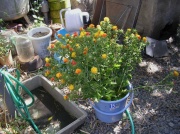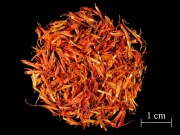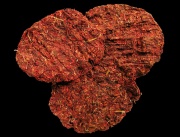Difference between revisions of "Safflower"
| (9 intermediate revisions by the same user not shown) | |||
| Line 1: | Line 1: | ||
[[File:Safflower_plant.jpg|thumb|Safflower plant]] | [[File:Safflower_plant.jpg|thumb|Safflower plant]] | ||
== Description == | == Description == | ||
| − | + | [[File:safflower_raw_1.jpg|thumb|Safflower (''Carthamus tinctorius'')]] | |
A thistle plant, ''Carthamus tinctorius'', originally found in Egypt and southern Asia. Safflower was also cultivated in Europe for the [[safflower oil|oil]] in its seeds. The flowers of the safflower plant contain a yellow dye and a red dye. The yellow colorant, safflor, is water soluble. The red dye, [[carthamin]], is extracted from the dried, crushed flower heads with a weak alkali solution after the yellow has been removed with cold water. The yellow color was rarely used while the red safflower was commonly used for dyeing red or pink [[silk]] and [[linen]] since ancient times. It was imported to Europe in the 18th century. Safflower red was used to dye government red tape and may have been used as a pigment. Carthamin is not a permanent color and is sensitive to [[acid|acids]], [[alkali|alkalis]], heat, and light. | A thistle plant, ''Carthamus tinctorius'', originally found in Egypt and southern Asia. Safflower was also cultivated in Europe for the [[safflower oil|oil]] in its seeds. The flowers of the safflower plant contain a yellow dye and a red dye. The yellow colorant, safflor, is water soluble. The red dye, [[carthamin]], is extracted from the dried, crushed flower heads with a weak alkali solution after the yellow has been removed with cold water. The yellow color was rarely used while the red safflower was commonly used for dyeing red or pink [[silk]] and [[linen]] since ancient times. It was imported to Europe in the 18th century. Safflower red was used to dye government red tape and may have been used as a pigment. Carthamin is not a permanent color and is sensitive to [[acid|acids]], [[alkali|alkalis]], heat, and light. | ||
| + | * See also [[https://cameo.mfa.org/wiki/Category:Uemura_dye_archive '''Uemera Dye Archive''' (Benibana)]] and [[https://cameo.mfa.org/wiki/Category:Natural_Dyes '''Dye Analysis''' (safflower)]] | ||
| + | [[File:05 Safflower_petal cakes.jpg|thumb|Safflower petal cakes]] | ||
[[[SliderGallery rightalign|Safflower color.PNG~EEM Color|Safflower l_ine.PNG~EEM Line]]] | [[[SliderGallery rightalign|Safflower color.PNG~EEM Color|Safflower l_ine.PNG~EEM Line]]] | ||
| − | |||
| − | |||
| − | |||
| − | |||
== Synonyms and Related Terms == | == Synonyms and Related Terms == | ||
| Line 19: | Line 17: | ||
* ISO R105 Lightfastness Classification = 1 | * ISO R105 Lightfastness Classification = 1 | ||
* CAS = 1401-20-3 | * CAS = 1401-20-3 | ||
| − | |||
| − | |||
| − | |||
| − | |||
| − | |||
| − | |||
| − | |||
| − | |||
| − | |||
| − | |||
== Additional Images == | == Additional Images == | ||
| Line 34: | Line 22: | ||
<gallery> | <gallery> | ||
File:beni_safflower.jpg|Beni | File:beni_safflower.jpg|Beni | ||
| + | Uemura_07-23-2009_239.jpg|Beni dyed silk in normal light Uemera Dye Archive | ||
| + | Uemura_07-23-2009_239_UV.jpg|Beni dyed silk in UV light<br>Uemera Dye Archive | ||
</gallery> | </gallery> | ||
| + | == Resources and Citations == | ||
| + | * J.Hofenk-de Graaf, ''Natural Dyestuffs: Origin, Chemical Constitution, Identification'', Central Research Laboratory for Objects of Art and Science, Amsterdam, September 1969. | ||
| − | + | * Analytical strategies for natural dyestuffs in cultural heritage objects - EU-ARTECH European research project - http://www.organic-colorants.org | |
* R.J. Adrosko, ''Natural Dyes in the United States'', Smithsonian Institution Press, Washington, DC, 1968 | * R.J. Adrosko, ''Natural Dyes in the United States'', Smithsonian Institution Press, Washington, DC, 1968 | ||
| Line 47: | Line 39: | ||
* John and Margaret Cannon, ''Dye Plants and Dyeing'', Herbert Press, London, 1994 | * John and Margaret Cannon, ''Dye Plants and Dyeing'', Herbert Press, London, 1994 | ||
| − | * ''Encyclopedia Britannica'', http://www.britannica.com Comment: "safflower." | + | * ''Encyclopedia Britannica'', http://www.britannica.com Comment: "safflower." (Accessed 5 Dec. 2004). |
* R.Feller, M.Curran, C.Bailie, 'Identification of Traditional Organic Colorants Employed in Japanese Prints and Determination of their Rates of Fading', ''Japanese Woodblock Prints'', Allen Memorial Art Museum, Oberlin College, Oberlin, 1984 | * R.Feller, M.Curran, C.Bailie, 'Identification of Traditional Organic Colorants Employed in Japanese Prints and Determination of their Rates of Fading', ''Japanese Woodblock Prints'', Allen Memorial Art Museum, Oberlin College, Oberlin, 1984 | ||
| Line 55: | Line 47: | ||
* Colour Index International online at www.colour-index.org | * Colour Index International online at www.colour-index.org | ||
| − | + | * J. Thornton, 'The Use of Dyes and Colored Varnishes in Wood Polychromy', ''Painted Wood: History and Conservation'', Getty Conservation Insitute, Los Angeles, 1998 | |
| − | |||
| − | * J. Thornton, 'The Use of Dyes and Colored Varnishes in Wood Polychromy', ''Painted Wood: History and Conservation'', | ||
* R. J. Gettens, G.L. Stout, ''Painting Materials, A Short Encyclopaedia'', Dover Publications, New York, 1966 | * R. J. Gettens, G.L. Stout, ''Painting Materials, A Short Encyclopaedia'', Dover Publications, New York, 1966 | ||
Latest revision as of 13:15, 22 June 2022
Description
A thistle plant, Carthamus tinctorius, originally found in Egypt and southern Asia. Safflower was also cultivated in Europe for the oil in its seeds. The flowers of the safflower plant contain a yellow dye and a red dye. The yellow colorant, safflor, is water soluble. The red dye, Carthamin, is extracted from the dried, crushed flower heads with a weak alkali solution after the yellow has been removed with cold water. The yellow color was rarely used while the red safflower was commonly used for dyeing red or pink Silk and Linen since ancient times. It was imported to Europe in the 18th century. Safflower red was used to dye government red tape and may have been used as a pigment. Carthamin is not a permanent color and is sensitive to acids, alkalis, heat, and light.
- See also [Uemera Dye Archive (Benibana)] and [Dye Analysis (safflower)]
Synonyms and Related Terms
Carthamus tinctorius; Natural Yellow 5; Natural Red 26; carthame (Fr.); faux safran (Fr.); Deutscher saflor (Deut.); cartamo (It., Esp.); saffloor (Ned.); beni (Jap.); benibana (Jap.); Färberdistel (Deut.); knikos (Gr.); karthamos (Gr.); saffloor (Ned.); cartamina (Port.); carthamus; bastard saffron; carthamin; distaff thistle; dyer's thistle; seaflower; African saffron; false saffron; safflor; rose carthame; saffron thistle; American saffron
Physical and Chemical Properties
- Safflor is soluble in water and is not lightfast.
- Carthamin is soluble in alkalis and slightly soluble in water.
- ISO R105 Lightfastness Classification = 1
- CAS = 1401-20-3
Additional Images
Resources and Citations
- J.Hofenk-de Graaf, Natural Dyestuffs: Origin, Chemical Constitution, Identification, Central Research Laboratory for Objects of Art and Science, Amsterdam, September 1969.
- Analytical strategies for natural dyestuffs in cultural heritage objects - EU-ARTECH European research project - http://www.organic-colorants.org
- R.J. Adrosko, Natural Dyes in the United States, Smithsonian Institution Press, Washington, DC, 1968
- Helmut Schweppe, Schweppe color collection index and information book
- Palmy Weigle, Ancient Dyes for Modern Weavers, Watson-Guptill Publications, New York, 1974
- John and Margaret Cannon, Dye Plants and Dyeing, Herbert Press, London, 1994
- Encyclopedia Britannica, http://www.britannica.com Comment: "safflower." (Accessed 5 Dec. 2004).
- R.Feller, M.Curran, C.Bailie, 'Identification of Traditional Organic Colorants Employed in Japanese Prints and Determination of their Rates of Fading', Japanese Woodblock Prints, Allen Memorial Art Museum, Oberlin College, Oberlin, 1984
- F. Crace-Calvert, Dyeing and Calico Printing, Palmer & Howe, London, 1876
- Colour Index International online at www.colour-index.org
- J. Thornton, 'The Use of Dyes and Colored Varnishes in Wood Polychromy', Painted Wood: History and Conservation, Getty Conservation Insitute, Los Angeles, 1998
- R. J. Gettens, G.L. Stout, Painting Materials, A Short Encyclopaedia, Dover Publications, New York, 1966
- G.S.Brady, Materials Handbook, McGraw-Hill Book Co., New York, 1971 Comment: p. 826
- Ralph Mayer, A Dictionary of Art Terms and Techniques, Harper and Row Publishers, New York, 1969 (also 1945 printing)
- R.D. Harley, Artists' Pigments c. 1600-1835, Butterworth Scientific, London, 1982
- The Merck Index, Martha Windholz (ed.), Merck Research Labs, Rahway NJ, 10th edition, 1983 Comment: entry 1918 - carthamus
- The American Heritage Dictionary or Encarta, via Microsoft Bookshelf 98, Microsoft Corp., 1998
- Thomas B. Brill, Light Its Interaction with Art and Antiquities, Plenum Press, New York City, 1980
- Art and Architecture Thesaurus Online, http://www.getty.edu/research/tools/vocabulary/aat/, J. Paul Getty Trust, Los Angeles, 2000







